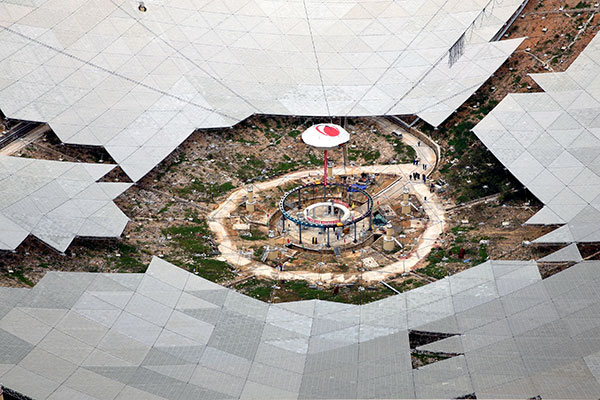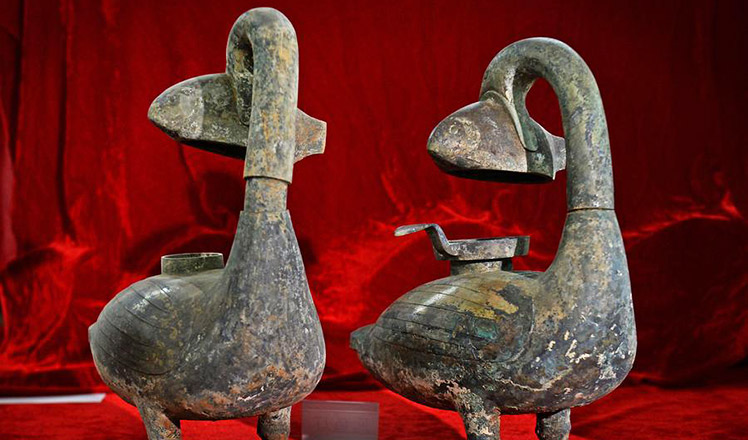Massive telescope's 30-ton 'retina' undergoes final test
Updated: 2015-11-23 07:45
By CHENG YINGQI/YANG JUN(China Daily)
|
||||||||
 |
|
Engineers have finished two-thirds of the panels of the gigantic radio telescope in Guizhou province as of Saturday. JIANG DONG/CHINA DAILY |
Key component put through its paces in dry run; FAST to become world's largest eye for scanning cosmos
Scientists carried out the last step in testing a key component of China's gigantic radio telescope on Saturday. After its scheduled completion in September, it will be the largest such telescope in the world.
A team successfully tested the installation of the telescope's "retina", a mechanism weighing 30 metric tons and suspended 140-160 meters above the half-finished reflector dish which will collect signals from the universe.
The telescope, 500 meters in diameter and usually known as FAST, is composed of 4,500 mostly triangular panels with sides measuring 11 meters that create a parabolic shape or hemisphere. The motion of the panels alters the collective shape of the antenna, which is capable of reflecting radio signals from the universe to a focal point, where the receiver dome sits.
"So far, one of the most important steps has been completed. We will finish installing all the panels by June 2016, and strive to debug the whole system by the end of September," Li Di, a chief scientist from the National Astronomical Observatories affiliated with the Chinese Academy of Sciences, told China Daily.
The working mechanism of FAST, or Five-hundred-meter Aperture Spherical Telescope, is similar to any television antenna on a roof, according to Li. But FAST is so much larger that "if you fill it with wine, every one of the world's seven billion people could get a share of about five bottles", he said.
FAST is unique because 4,350 panels have been designed to move up and down, which enables the whole hemisphere to rotate or to reshape.
"With a larger signal receiving area and more flexibility, FAST will be able to scan two times more sky area than Arecibo, with three to five times higher sensitivity," Li said.
FAST was first proposed in 1993 by Chinese astronomers, as one of several competing concepts for the international Square Kilometer Array project-a project by astronomers worldwide to build the next generation radio observatory.
"Ultimately, exploring the unknown is the nature of mankind, which is as visceral as feeding and clothing ourselves. It drives us to a greater future," he said.
Lister Staveley-Smith, an astronomer at the University of Western Australia, expects new discoveries from FAST, including previously unknown pulsars in the Milky Way and even in other more distant galaxies.
"The FAST's sensitivity and resolution will allow an extremely comprehensive study of thousands of galaxies in different environments in the local universe," he said in an e-mail exchange with China Daily.
Chris Salter, head of the Radio Astronomy Group at Arecibo, said the 305-meter radio telescope and FAST are both similar in many aspects and complementary to each other. "I have no doubt that FAST counts as being a very exciting development for radio astronomy, and I enthusiastically await the commissioning of the new telescope," he wrote in an e-mail.
Contact the writers at chengyingqi@chinadaily.com.cn
- London tube station evacuated over security threat
- China law firm Yingke opens China Center in London
- ROK accepts DPRK's proposal for working-level talks
- DPRK proposes working-level talks with S. Korea
- France, Russia launch more strikes against IS targets in Syria
- Chinese bearing maker prepares Michigan facility

 Indian PM praises Premier Li's philosophy on economy
Indian PM praises Premier Li's philosophy on economy
 Snow hits North China as temperature drops
Snow hits North China as temperature drops
 'Burn the Floor' thrills its Beijing audience
'Burn the Floor' thrills its Beijing audience
 Where do China's damaged currency notes go?
Where do China's damaged currency notes go?
 Shenyang's 50 gas-electric hybrid buses to hit the road
Shenyang's 50 gas-electric hybrid buses to hit the road
 Top 10 global innovators in 2015
Top 10 global innovators in 2015
 Leaders attend APEC welcome dinner in Manila
Leaders attend APEC welcome dinner in Manila
 Amazing finds unearthed at the Marquis of Haihun's tomb
Amazing finds unearthed at the Marquis of Haihun's tomb
Most Viewed
Editor's Picks

|

|

|

|

|

|
Today's Top News
Chinese president arrives in Turkey for G20 summit
Islamic State claims responsibility for Paris attacks
Obama, Netanyahu at White House seek to mend US-Israel ties
China, not Canada, is top US trade partner
Tu first Chinese to win Nobel Prize in Medicine
Huntsman says Sino-US relationship needs common goals
Xi pledges $2 billion to help developing countries
Young people from US look forward to Xi's state visit: Survey
US Weekly

|

|






